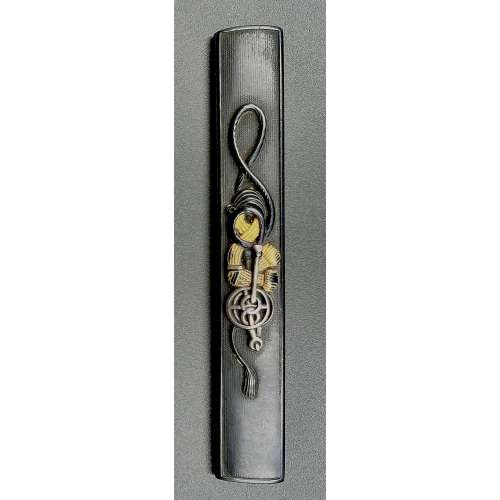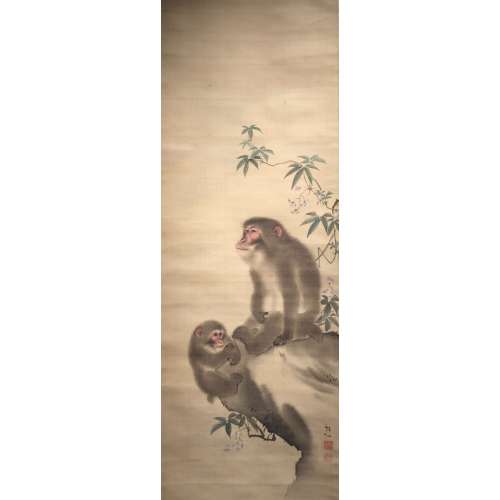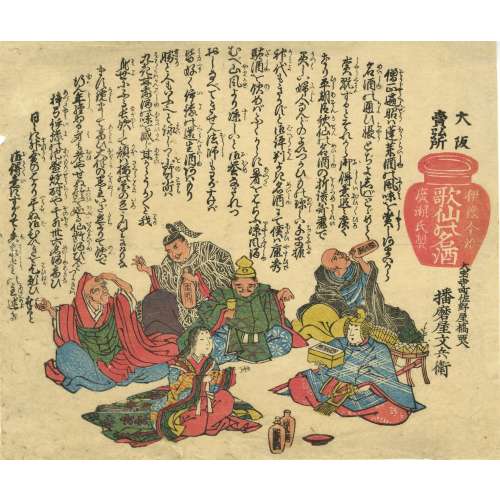
 Though we have to admit that the example from Catalog #7 by Robert E. Haynes looks much stronger.
Though we have to admit that the example from Catalog #7 by Robert E. Haynes looks much stronger.
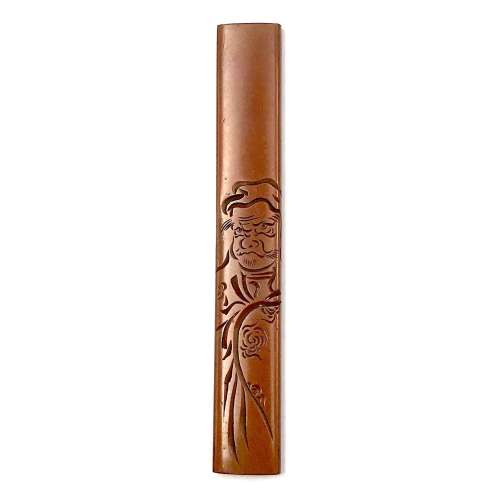

 Though we have to admit that the example from Catalog #7 by Robert E. Haynes looks much stronger.
Though we have to admit that the example from Catalog #7 by Robert E. Haynes looks much stronger.
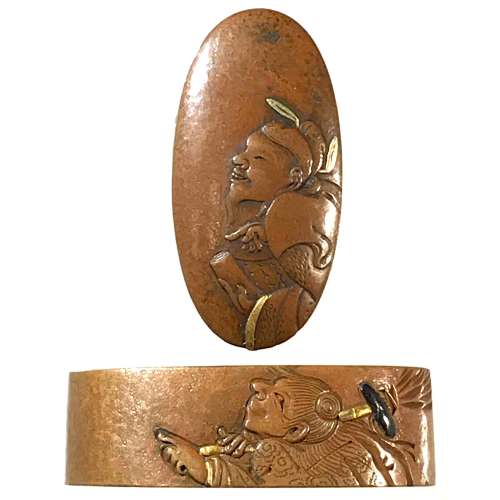
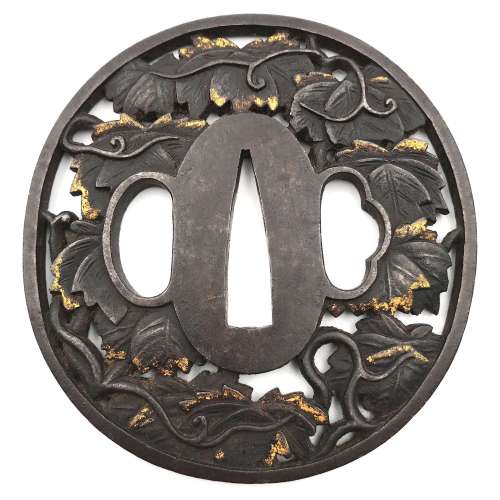
An iron tsuba of slightly vertically elongated circular form carved and pierced with a mass of ivy (tsuta) leaves and tendrils, details damascened with gold in nunome-zōgan technique. Hitsu-ana with raised rim.
Unsigned.
Chōshū school.Height: 72.0 mm; width: 69.0 mm; thickness: 4.7 mm; Weight: 92 g.
According to John W. Dower, "ivy bears fairly close resemblance to both maple leaf and grape leaf". However, I consider this tsuba decorated with ivy leaves for several reasons, such as the lack of racemations in the presence of tendrils.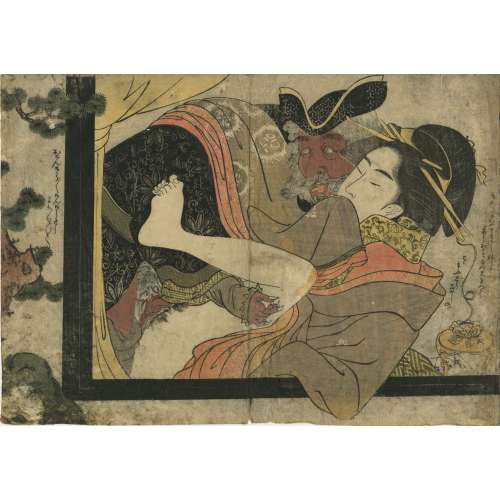
 №1: "...one of the most exotic scenes in all shunga. A Dutch kapitan is discovered coupling with a lovely Japanese courtesan, beside a large window opening upon a garden...".
№1: "...one of the most exotic scenes in all shunga. A Dutch kapitan is discovered coupling with a lovely Japanese courtesan, beside a large window opening upon a garden...".

 №2: "...a fair young harlot is seen masturbating with a grinding-pestle - a man watches intently from under bedding." [I have two specimens of this design; the one from album is more soiled but less faded].
№2: "...a fair young harlot is seen masturbating with a grinding-pestle - a man watches intently from under bedding." [I have two specimens of this design; the one from album is more soiled but less faded].
 №3: "...the artist has effectively contrasted the lovers by depicting the man's face as seen through the geisha's gauze skirt. [...] we are impressed more by strikingly elegant composition, the dramatic coloring, rather than feeling any great urge to participate in the energetic proceedings..."
№3: "...the artist has effectively contrasted the lovers by depicting the man's face as seen through the geisha's gauze skirt. [...] we are impressed more by strikingly elegant composition, the dramatic coloring, rather than feeling any great urge to participate in the energetic proceedings..."
 №4: "This scene is a most straightforward one, featuring the standard Missionary Position [capitalization by R. Lane].; but withal, the contrast of the young and naked, secret lover and the richly-clothed courtesan amid luxurious bedding..."
№4: "This scene is a most straightforward one, featuring the standard Missionary Position [capitalization by R. Lane].; but withal, the contrast of the young and naked, secret lover and the richly-clothed courtesan amid luxurious bedding..."
 №5: "In a striking lesbian scene (which has no equivalent in Utamaro, and is, incidentally, often omitted in later editions of this album), the girl at left prepares to receive the harikata (dildo) worn by the older girl at right (who holds a seashell containing lubricant)."
№5: "In a striking lesbian scene (which has no equivalent in Utamaro, and is, incidentally, often omitted in later editions of this album), the girl at left prepares to receive the harikata (dildo) worn by the older girl at right (who holds a seashell containing lubricant)."
 №6: "In the first appearance of a matronly heroine in this series, we find a widow - with shaven eyebrows and clipped hair - sporting with a handsome yound shop-clerk, mounting him with all her might."
№6: "In the first appearance of a matronly heroine in this series, we find a widow - with shaven eyebrows and clipped hair - sporting with a handsome yound shop-clerk, mounting him with all her might."

 №7: "... lady of samurai court: here, shown taking advantage of an official outing to temple and theatre, to rendezvous with a secret lover on a teahouse balcony." R. Lane considers this design the least successful in the series, especially in comparison with the same theme by Utamaro: "Utamaro female is almost ferocious in her lust for sexual gratification", which does not sound true to me. See Utamaro's sheet №5 from the album Utamakura (歌まくら, Poem of the Pillow) [courtesy The British Museum without permission]:
№7: "... lady of samurai court: here, shown taking advantage of an official outing to temple and theatre, to rendezvous with a secret lover on a teahouse balcony." R. Lane considers this design the least successful in the series, especially in comparison with the same theme by Utamaro: "Utamaro female is almost ferocious in her lust for sexual gratification", which does not sound true to me. See Utamaro's sheet №5 from the album Utamakura (歌まくら, Poem of the Pillow) [courtesy The British Museum without permission]:
 Then, as Richard Lane states, "we are flung suddenly to the bottom rung of Edo society":
Then, as Richard Lane states, "we are flung suddenly to the bottom rung of Edo society":
 №8: "Here we find a fair yotaka ('night-hawk', e.i. streetwalker) accommodating a lusty client in a lumberyard by the bank of the Sumida River".
№8: "Here we find a fair yotaka ('night-hawk', e.i. streetwalker) accommodating a lusty client in a lumberyard by the bank of the Sumida River".
 №9: '... a slightly plump harlot of the lower class receives a night visit from her lover, whose naked form she tries to cover with a cloak."
№9: '... a slightly plump harlot of the lower class receives a night visit from her lover, whose naked form she tries to cover with a cloak."
 №10: "...likely maidservant and lackey - are depicted in bath-room, their passions are all too obviously fired by steaming water."
№10: "...likely maidservant and lackey - are depicted in bath-room, their passions are all too obviously fired by steaming water."
 №11: "...this scene of courtesan and secret lover ranks high not only in Eiri's œuvre but also in the annals of the ukiyo-e genre itself. Both design and colouring are impeccable and, for this period, there is nothing even in the work of great Utamaro that really surpasses it." Again, a doubtful statement, however, this is Utamaro's design for the reader to judge:
№11: "...this scene of courtesan and secret lover ranks high not only in Eiri's œuvre but also in the annals of the ukiyo-e genre itself. Both design and colouring are impeccable and, for this period, there is nothing even in the work of great Utamaro that really surpasses it." Again, a doubtful statement, however, this is Utamaro's design for the reader to judge:
 The last design in my album is this:
The last design in my album is this:
 #13: In most reference books it goes under number 13, and we will assign this number to the sheet. "The final scene of the album features naked participants, probably samurai man and wife. The print is rather subdued in tone and colour, if not in the degree of the passion displayed..."
An additional sheet, acquired separately from a reputable dealer in New York, is usually listed as №12:
#13: In most reference books it goes under number 13, and we will assign this number to the sheet. "The final scene of the album features naked participants, probably samurai man and wife. The print is rather subdued in tone and colour, if not in the degree of the passion displayed..."
An additional sheet, acquired separately from a reputable dealer in New York, is usually listed as №12:
 №12: "One might think that Eiri has reached his peak with the preceding plate 11 - and indeed he has, in both esthetic and erotic terms. But the album is not yet finished, and the next scene lends a needed variety to the series, a slightly comic tableau featuring a middle-aged lackey attempting to forcibly seduce a servant girl of the same domicile". Utamaro's design, that inspired Eiri is here:
№12: "One might think that Eiri has reached his peak with the preceding plate 11 - and indeed he has, in both esthetic and erotic terms. But the album is not yet finished, and the next scene lends a needed variety to the series, a slightly comic tableau featuring a middle-aged lackey attempting to forcibly seduce a servant girl of the same domicile". Utamaro's design, that inspired Eiri is here:
 All descriptions are taken from Richard Lane's article at The Complete Ukiyo-e Shunga №9 Eiri, 1996. He concluded: "...Eiri's erotic series represents a major contribution to shunga art towards the close of ukiyo-e "Golden Age". In part inspired by Utamaro's classic album, this series withal constitutes a unified and original achievement, providing a cumulative effect of gracefully elegant yet glowing eroticism, which remains in the mind's eye long after the pictures themselves are far away."
I only would like to mention here that in several reference sources this album goes under name of Eisho; unfortunately, this mistake is reproduced at www.ukiyo-e.org, which miraculously shows exactly my print, but under the wrong name of the artist. The same mistake can be found at Shunga. The art of love in Japan. Tom and Mary Anne Evans. Paddington Press Ltd., 1975. ISBN 0-8467-0066-2; plates 6.74-6.77: Chōkyōsai Eishō, c. 1800. Even the British Museum edition of 2010 gives the same erroneous attribution: Chōkyōsai Eishō (1793-1801); they provide the following translation of title: "Clean Draft of a Letter" [see: Shunga. Erotic art in Japan. Rosina Buckland. The British Museum Press, 2010; pp. 110-112]. To the honour of the British Museum, I must admit that they have corrected themselves in Shunga. Sex and pleasure in Japanese art. Edited by Timothy Clark, et al. Hotei Publishing, 2013. Now, they say Chōkyōsai Eiri (worked c. 1790s-1801); they also provide a new title: "Neat Version of the Love Letter, or Pure Drawings of Female Beauty". I have already mentioned Richard Lane's version of title: "Love-letters, Love Consummated", and Chris Uhlenbeck's "Models of calligraphy". In poorly designed and printed Shunga. Erotic figures in Japanese art. Presented by Gabriele Mandel. Translated by Alison L'Eplattenier. Crescent Books, New York, 1983, the artist is named Shokyosai Eisho (beginning of the 19th century); title provided: "Models of Calligraphy". Correct attribution to Chōkyōsai Eiri also can be found at Poem of the pillow and other stories by Utamaro, Hokusai, Kuniyoshi and other artists of the floating world. Gian Carlo Calza in collaboration with Stefania Piotti. Phaidon Press, 2010; though the title is translated as "Clean Copy of Female Beauty".
All descriptions are taken from Richard Lane's article at The Complete Ukiyo-e Shunga №9 Eiri, 1996. He concluded: "...Eiri's erotic series represents a major contribution to shunga art towards the close of ukiyo-e "Golden Age". In part inspired by Utamaro's classic album, this series withal constitutes a unified and original achievement, providing a cumulative effect of gracefully elegant yet glowing eroticism, which remains in the mind's eye long after the pictures themselves are far away."
I only would like to mention here that in several reference sources this album goes under name of Eisho; unfortunately, this mistake is reproduced at www.ukiyo-e.org, which miraculously shows exactly my print, but under the wrong name of the artist. The same mistake can be found at Shunga. The art of love in Japan. Tom and Mary Anne Evans. Paddington Press Ltd., 1975. ISBN 0-8467-0066-2; plates 6.74-6.77: Chōkyōsai Eishō, c. 1800. Even the British Museum edition of 2010 gives the same erroneous attribution: Chōkyōsai Eishō (1793-1801); they provide the following translation of title: "Clean Draft of a Letter" [see: Shunga. Erotic art in Japan. Rosina Buckland. The British Museum Press, 2010; pp. 110-112]. To the honour of the British Museum, I must admit that they have corrected themselves in Shunga. Sex and pleasure in Japanese art. Edited by Timothy Clark, et al. Hotei Publishing, 2013. Now, they say Chōkyōsai Eiri (worked c. 1790s-1801); they also provide a new title: "Neat Version of the Love Letter, or Pure Drawings of Female Beauty". I have already mentioned Richard Lane's version of title: "Love-letters, Love Consummated", and Chris Uhlenbeck's "Models of calligraphy". In poorly designed and printed Shunga. Erotic figures in Japanese art. Presented by Gabriele Mandel. Translated by Alison L'Eplattenier. Crescent Books, New York, 1983, the artist is named Shokyosai Eisho (beginning of the 19th century); title provided: "Models of Calligraphy". Correct attribution to Chōkyōsai Eiri also can be found at Poem of the pillow and other stories by Utamaro, Hokusai, Kuniyoshi and other artists of the floating world. Gian Carlo Calza in collaboration with Stefania Piotti. Phaidon Press, 2010; though the title is translated as "Clean Copy of Female Beauty".
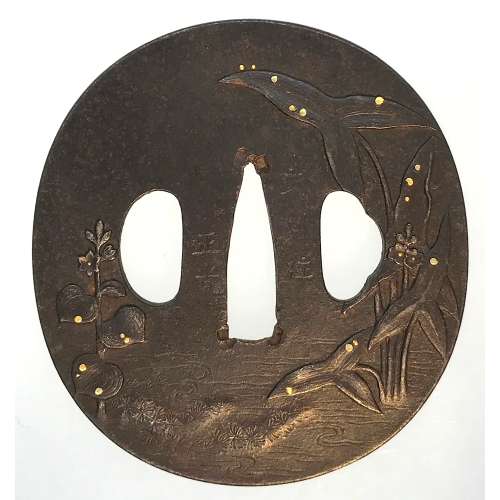
An iron tsuba of oval form decorated with a water plantain (omodaka) carved in low relief and water drops inlaid in gold.
Signed: Bushū jū Masamitsu.
Bushū-Itō school.Height: 71.8; Width: 67.3; Thickness: 3.6; Weight: 96 g.
Mid to late Edo period; 18th-19th century.
There were several tsuba artists with the name of Masamitsu. The one who worked with iron and spelled [正光] is mentioned at Markus Sesko's 'Genealogies' on page 106 in Akasaka School of Edo section as Masamitsu Gorōbei , student of Tadatoki, 4th generation Akasaka master. The name is not mentioned at Torigoye/Haynes 'Tsuba. An Aesthetic Study' in the list of Bushū-Itō family masters on page 181.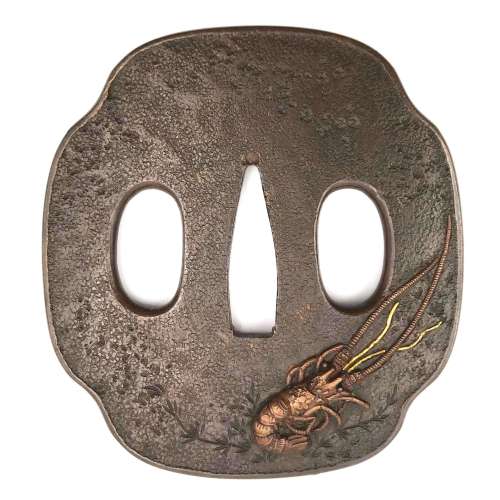
Bronze tsuba of mokkō form with narrow slightly raised rim carved in kebori with the sea weed and inlaid with a lobster (ebi) made of copper on the face and two sea shells made of shakudo on the back. Lobster's antennae inlaid in gold, and eyes inlaid in shakudo. Ishime-ji treated surface.
Unsigned.
Late Edo period (mid-19th century). Dimensions: 76.3 x 71.1 x 3.7 mm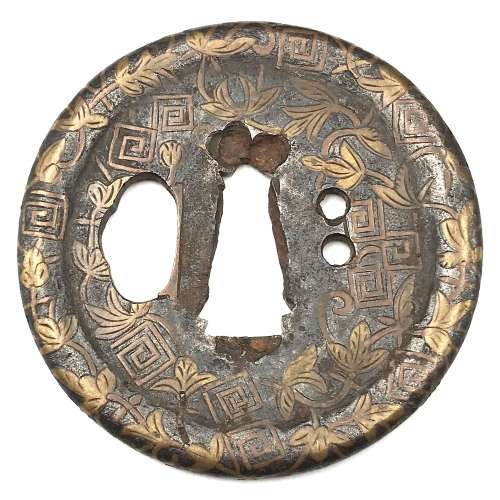
Iron tsuba of round form with dam-shaped rim (dote-mimi) pierced with hitsu-ana and two udenuki-ana (probably cut later on) decorated in flat inlay (hira-zōgan) with vines and symbols of thunder or lightning (possibly - family crest, mon). Hitsu-ana and nakago-ana with copper sekigane.
Ōnin or Heianjō school, or, possibly Kaga or Umetada school. Momoyama period or earlier (Muromachi), 16th century. Unsigned.Size: 64.5 x 63.8 x 2.2 (center), 4.2 (rim) mm.
Provenance: Lundgren Collection: [Japanese sword-fittings and metalwork in the Lundgren Collection. Published by Otsuka Kogeisha Co., Ltd., Tokyo 1992], №31; The Lundgren Collection of Japanese Swords, Sword Fittings and A Group of Miochin School Metalwork. Christie's Auction: Tuesday, 18 November 1997, London. Sales "GOTO-5881". Christie's, 1997, №2. Lundgren's description at Christie's: Heianjo tsuba. Unsigned. The circular plate decorated in brass hirazogan with flowers, plants and symbols of thunder, dote mimi and udenuki ana, late Muromachi period (16th century). Tokyo 1992 description: Sword guard with design of flowering plants and frets in inlay. Unsigned. Heianjo inlay school. 6.35 x 6.3 cm, thickness of rim 0.40 cm. Iron. Flat brass inlay. Muromachi-Momoyama Period, 16th century. Provenance: The Second John Harding. A somewhat look-a-like pieces can be found in various catalogues. The one in Naunton Collection, №172, is signed: Umetada of Yamashiro: "Iron, small, almost circular, with raised oval rim, inlaid all over with leaves and scrolls in brass hirazōgan."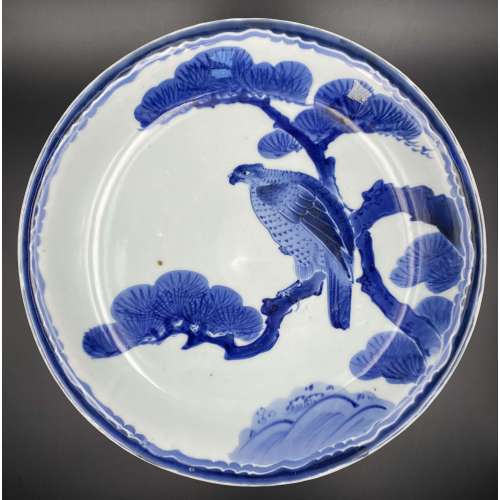
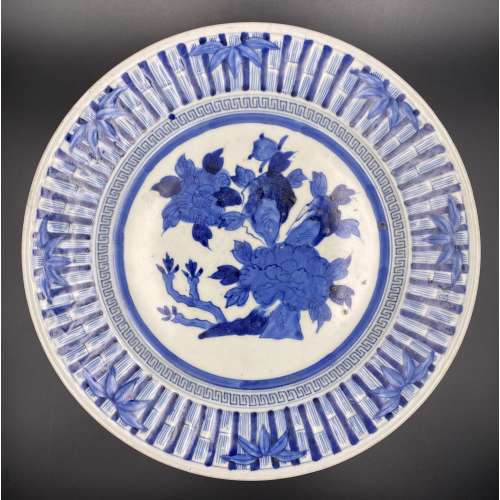
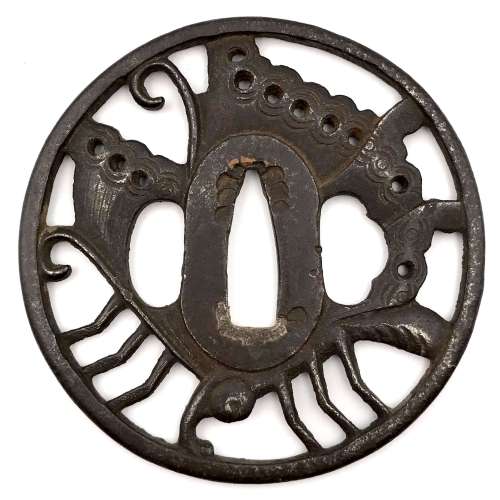

Haynes Catalog #6, lot 30.

Haynes Catalog #9, lot 143.

Caldwell Collection, #13.
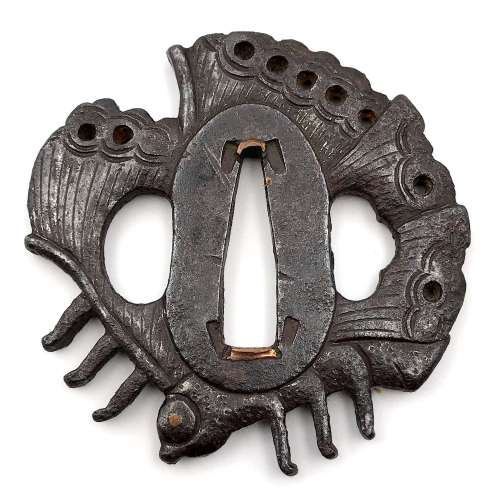
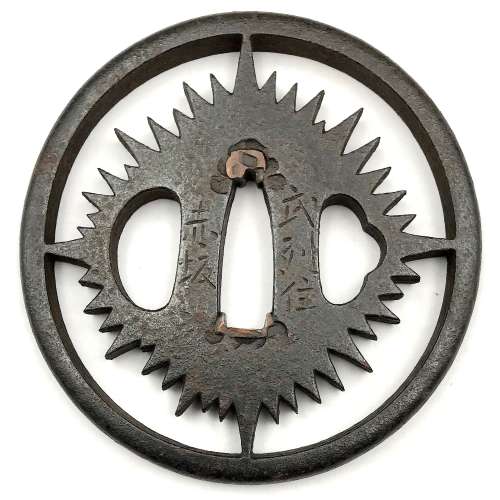
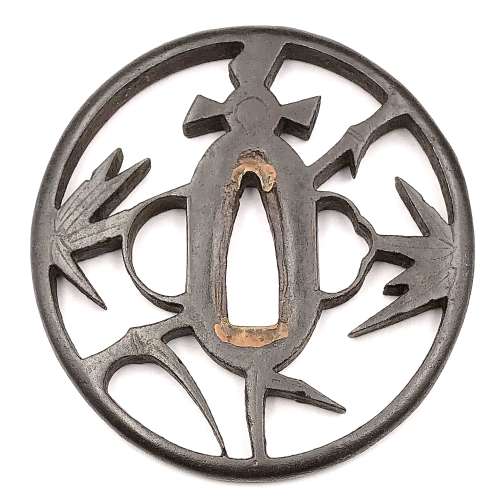
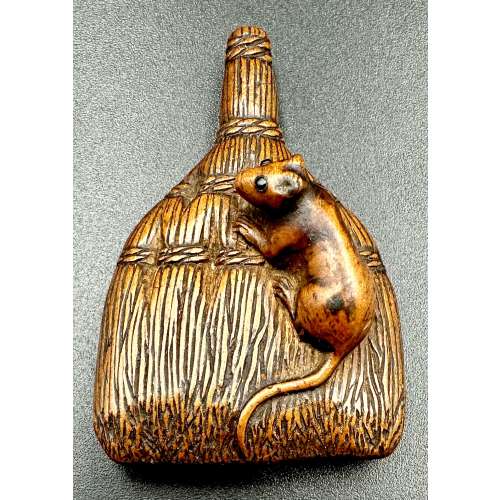
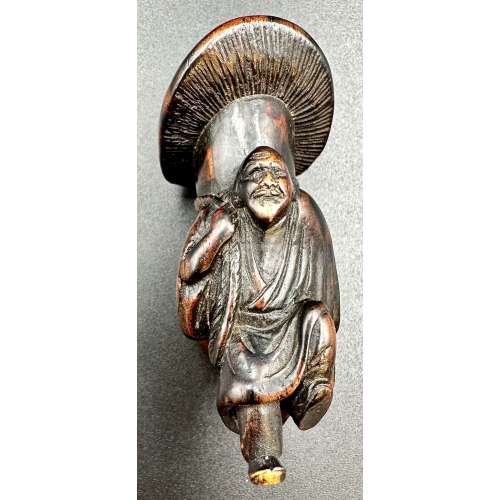
Netsuke with a design of an old man carrying a giant mushroom on his back. Possibly signed on his left foot. According to Merrily Baird (Symbols of Japan, page. 93): ... This prominent use in the symbol-rich netsuke art form, however, reflects more their sexual symbolism than either their dietary appeal or interesting shapes. Mushrooms in Japan are generally a symbol of fertility, with some flat varieties, like shiitake, being associated with females. In contrast, the matsutake mushroom (Armillaria edodes) is a phallic symbol, as befits its thick, spearlike stem and the fact that it is consumed before cap opens.
Seller's description: "The old man carved walking, with one foot slightly raised, wearing a loose fitted robe and carrying a large long-stemmed mushroom on his back. The wood stained and bearing a fine patina. Himotoshi through the mushroom stem". See VO-0270.2018 for the same subject. Late 18th century. Dimensions: 62 mm tall